|
"Wild - Scenic" is the designation
of the Michigan Natural Rivers Program for the Fox River,
and those words perfectly describe our Sierra Club trip down
the river. The Fox promised our small group both wild challenges
to our skills and scenic rewards for our efforts. I had kayaked
down the river a few years ago and could still replay the
boisterous sound of coyotes barking in the cool evening of
a fall day.
When promised crisp October days and the
musty smell of yellow leaves lingering in the woods, Linda,
my wife, quickly signed up for this trip as bow paddler. With
the Old Town Canadienne on the roof, we drove north for the
Thursday night rendezvous at the Fox River State Forest Campground
a few miles north of Seney. Already there was trip co-leader
Mike Neiger. Joining us at the campsite that evening were
Mary Powell and Bill Host.
In the morning, Jim Orris and Randy Orchard
arrived with another tandem canoe. We dragged the boats to
the stream where the sounds of "Chickadee, dee, dee"
gave way to the "tap, tap, tap" of brittle leaves
dropping gently on the bare, stiff twigs of the streamside
brush. After the cold 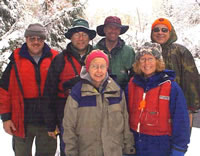 light
of the full moon, even the low morning sun helped warm our
faces and spirits. light
of the full moon, even the low morning sun helped warm our
faces and spirits.
Mary Powell, Linda
De Kock, Randy Orchard,
Bill Host, Michael Neiger,
and Jim Orris, left to right
(Photo by Gary De Kock)
The river trip began at 10:30 AM when the
five canoes floated free of the bank and snaked down the winding
river's course. Linda and I led and worked on resurrecting
the teamwork skills necessary to get a seventeen foot canoe
down an Upper Peninsula river.
At one point we stopped and watched as
Jim and Randy came around an upstream bend. Suddenly their
canoe tipped and the two men were dumped with an icy splash
into the cold water. Because they were on the inside of the
bend, they found the water shallow and the current slow. This
allowed them to stand and work to retrieve their equipment.
One glove was lost but all else was collected.
A quick streamside change into dry clothes broke the chill
of the swim and both paddlers were soon back in their canoe
and ready to continue the adventure.
As we regrouped after the spill, another
group of canoeists moved past us on the river. From my point
of view, they looked poorly prepared for travel on this stream.
Each canoe was top heavy because it was piled high above the
gunwales with equipment.
These heavy loads of unnecessary gear would
require backbreaking efforts to get around and over the many
trees that would certainly block this narrow, winding stream.
I had the feeling that the river had much to teach these paddlers
and that they had chosen to learn the hard way.
We caught up with them at the next portage
where a large tree had fallen clear across the stream. One
paddler wearing waders was struggling to drag a huge pile
of gear through the bush.
Mike and I volunteered to carry one of
his coolers and found it heavier than some solo canoes. We
did not offer to help carry the chain saw or lawn chairs.
The better paddlers in their group 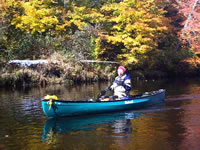 went
on down the river and left the beginners to struggle with
the river. went
on down the river and left the beginners to struggle with
the river.
Mary Powell enjoys the
pleasures of paddling solo
in a group on the remote,
unspoiled Fox River
(Photo by Gary De Kock)
Steering an overloaded canoe from the back
is not easy for an experienced paddler and these frustrated
beginners kept getting pushed broadside into trees downed
on the outside of many turns. We helped them to keep going
but they were ready to quit their trip at the first chance.
Eventually their entire group pulled over and we were free
to move ahead for good.
Our group was better prepared and could
therefore enjoy the river. The frequent whistle of wings as
ducks burst from around the next bend let us know that the
Fox had pleasant surprises in store for us. Shortly after
the M-28 bridge, the stream made its first split at the beginning
of the "spreads".
This can be a difficult section of the
river for newcomers who may end up in a dead end channel or
wedged in a tight turn. Fortunately Mike has been here frequently
and steered us through the maze without a wrong turn. By always
keeping the canoe behind in 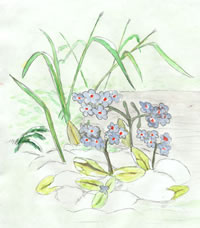 view,
we were able to keep the group together at every fork in the
channel. In this low-lying area, there are few high spots
that make good campsites. view,
we were able to keep the group together at every fork in the
channel. In this low-lying area, there are few high spots
that make good campsites.
Forget-me-nots and a
fresh blanket of snow
create a unique,
streamside sight for paddlers.
(Painting by Mary Powell)
Our goal was one of the first areas of
high ground downstream of the spreads. Around 6:00 PM, an
excellent spot was reached and all were ready to get a hot
meal going on the stove. No coyotes called that night. Instead,
the wind pulsed though the empty branches and rattled the
leaves. We slept knowing the wild, scenic river would welcome
us to another day of exploration and discovery.
Saturday looked like another day of surprises.
Our first challenge on the river was to maneuver around a
nasty tangle of fresh fallen pine tree. Trees newly fallen
have more limbs than those chewed up by spring floods. There
are also no limbs removed by earlier canoe parties with saws.
We began by paddling upstream. This left
us room to turn around and line up with a narrow opening on
the inside of the bend. This approach kept us out of the fast
current, deep water, and tangled logjam on the outside of
the bend. One by one each canoe threaded the narrow gap between
branches and bank. It's easy if you work with the river and
use your experience to avoid 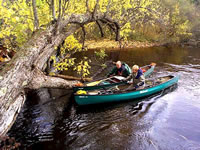 overestimating
your ability to move the canoe against the flow. overestimating
your ability to move the canoe against the flow.
Sweepers
and strainers are
common on
the Fox River
(Photo by Gary De Kock)
The weather alternated from rain to sun
depending on if a big dark cloud was overhead at the time.
A sunlit spot of warm dry grasses made a perfect lunch stop.
The group was moving confidently and smoothly down the river
and late afternoon saw us reach our planned campsite where
the stream made a tight loop.
Two heavy pines had recently lost their
toehold on the undercut bank and now lay uprooted in the streambed.
The campsite was now also a portage trail. Tents and tarps
were quickly set and soon the only sound was the occasional
stirring of an aluminum pot on a simmering stove.
The river had saved the biggest surprise
for Sunday morning. Rain had turned to snow. For some this
would have been a change for the worse. For us, this was the
creation of an enchanted forest. In the still night air, every
limb and twig had been piled high with the fresh flakes of
white. In the morning sun, all was draped with sparkling crystals.
We ran about taking pictures of the black
limbs outlined in white and tangled against the sky. I had
laid the canoe upside down next to our tent the night before.
Now it was covered with snow. When I rolled it over, a patch
of bare ground appeared from underneath. 
Because the canoe had sheltered the ground
from the gently falling snow, the shape on the ground looked
like a canoe. It was a "snow shadow".
October snow flakes
(Drawing by Mary Powell)
Our cooking tarp, strung between trees,
had also left a snow shadow. A tap on the straining fabric
and an avalanche of snow slid down the sloping nylon to the
ground.
Later that morning, the occasional plop
of snow loosened from a treetop perch by the warming air caused
me to duck my head for fear of a collar full of the cold,
wet stuff.
The Fox ends when joined by the smaller
Manistique River. Here the channel is wider and the going
is easier because fallen trees never block the river.
The day continued to warm and blue skies
reflected in the slow moving water. When we reached the town
of Germfask, an outfitter saw us pass his property and correctly
guessed that we were the "Sierra Club" group.
I like to think it was because we were
on schedule, well equipped, and smiling. He knew the other
group was on the river and was concerned about them. Rightly
so because, unlike us, they were behind schedule, poorly equipped,
and probably not speaking to each other by now.
The bridge at the Ten Curves Road signaled
that we were nearing the final take out. A few more bends
and we reached the parking area at the M-77 bridge. After
a quick change of clothes and good-byes to old and new friends,
we drove south with thoughts of snow shadows melting on the
banks of the wild and scenic Fox River.
Read
another journal...
|


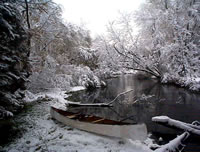
 light
of the full moon, even the low morning sun helped warm our
faces and spirits.
light
of the full moon, even the low morning sun helped warm our
faces and spirits.  went
on down the river and left the beginners to struggle with
the river.
went
on down the river and left the beginners to struggle with
the river.  view,
we were able to keep the group together at every fork in the
channel. In this low-lying area, there are few high spots
that make good campsites.
view,
we were able to keep the group together at every fork in the
channel. In this low-lying area, there are few high spots
that make good campsites.  overestimating
your ability to move the canoe against the flow.
overestimating
your ability to move the canoe against the flow. 